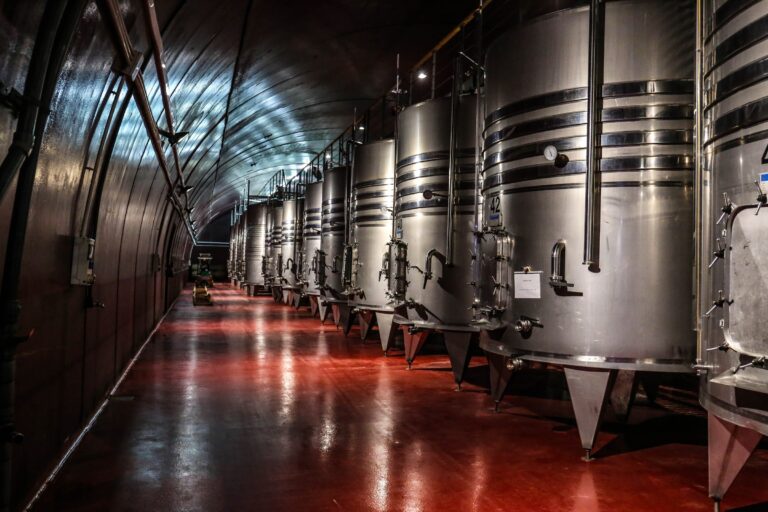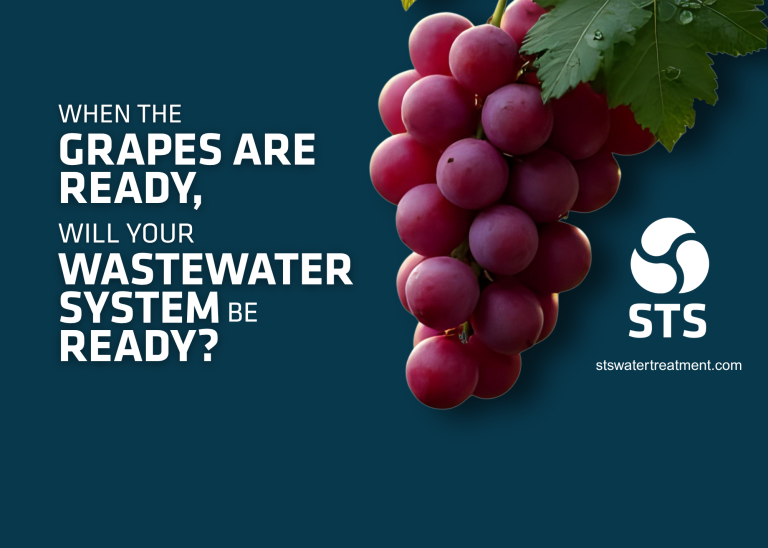Winery Wastewater Treatment Glossary
Activated Sludge: A brownish flocculent of bacterial organisms developed in aeration tanks.
Activated Sludge Process: Method of eliminating pollution in wastewater. Oxygen is released into tanks containing dissolved organic substances. Bacteria in the tanks break down the organic pollutants. Water is then separated from the activated sludge and discharged. Most of the sludge is reused in the treatment process; the remainder is disposed of per local wastewater regulations.
Aeration: Process of bringing air into contact with a liquid. It can be developed using natural wind on a pond or by injecting air into an aeration tank.
Aerobic Bacteria: Bacteria that require free oxygen for growth.
Aerobic Wastewater Treatment: It uses bacteria to break down waste; the bacteria require the presence of oxygen to live and thrive.
Anaerobic Bacteria: Bacteria that grow without the presence of free oxygen; it derives oxygen from breaking down waste
Anaerobic Wastewater Treatment: Uses bacteria to break down waste without needing the presence of oxygen. Bacteria thrive off the oxygen created from the waste.
Alkalinity: Alkaline fluids have a pH value of over 7. The number refers to the measurement of dissolved alkaline substances in the water (carbonates, bicarbonates, hydroxides, and occasionally borates, silicates, and phosphates) that can neutralize the acid. The higher the number, the more alkaline the liquid.
Biochemical Oxygen Demand (BOD): The amount of oxygen needed by bacteria and microorganisms in a unit volume of wastewater to consume dissolved oxygen and organic substances, converting it into carbon dioxide and cellular material. It is usually measured in milligrams per liter (mg/l) and is most frequently stated as the percentage removed during treatment or remaining after treatment.
Biosolids: Organic material that remains after aerobic wastewater treatment; this dewatered sludge can usually be re-used.
Clarifier: Usually a holding tank that allows solids to settle for separation.
Chemical oxygen demand (COD): The amount of chemical oxidant required to break down organic compounds in a unit volume of wastewater, including non-biodegradable and BOD.
Combined Wastewater: Combining sanitary wastewater and stormwater run-off for treatment.
Dewatering: The removal of water from sludge or other wastewater solids.
Digestion: The biochemical decomposition of organic matter; byproducts are methane gas, carbon dioxide, sludge solids, and water.
Dissolved Oxygen: The amount of oxygen dissolved in wastewater. It is measured in milligrams per liter.
Dissolved solids: Solids suspended in sewage that cannot be removed by laboratory filtering, such as minerals. These are generally smaller than two micrometers.
Effluent: The final liquid produced by a wastewater treatment system.
Equalization Tank (EQ Tank): A tank that provides consistent flow into the wastewater treatment system by managing flow fluctuations. Aeration and mixing are used to prevent the wastewater from becoming septic; it also maintains solids in suspension.
Grease: Refers to substances in wastewater such as waxes, fats, oils, soaps, etc.
Grit: not sure about this one – Heavy, inorganic materials such as pebbles or sand.
Inorganic Material: Material that cannot be broken down by bacteria, such as sand, stone, etc.
Membrane Bioreactor: (MBR): A membrane is used as a filter to remove solid materials, which disinfect and clarifies the effluent. It also uses low-pressure microfiltration and ultrafiltration. The membrane helps ensure that solids don’t settle. The process reduces sedimentation and produces high-quality effluent.
Micro-organisms: Microscopic plants and animals such as algae, bacteria, and molds.
Moving Bed Biofilm Reactor (MBBR): An activated sludge aeration system using tanks with large internal surface areas for biofilm growth. The surface area size reduces the footprint of the tanks. The process can be aerobic or anaerobic and operates at high-volume loads.
Nitrogen: An element found in wastewater in various forms; it is usually ammonia and nitrate.
Nutrient: Any substance consumed by organisms that leads to the growth and replacement of the organisms.
Organic Matter: Waste that originates from plants or animals.
Organic Material: Something that bacteria can break down, including fat, meat, or plants.
Oxidation: Using bacteria, oxygen, or chemicals to convert organic material to a more stable form
pH: A scale measuring water’s acidity or alkalinity. 7 is neutral; under 7 is acidic or base; over 7 is alkaline or caustic.
Process Wastewater: Water that comes into direct contact with raw material or products during manufacturing or processing or is a byproduct from a production process. It is no longer clean water.
Reactor: A tank with wastewater and sludge mixed so biochemical reactions can occur.
Return Activated Sludge (RAS): Activated sludge is continuously returned to the aeration tank, thus providing bacteria for incoming wastewater.
Sanitary Wastewater: Water from residential, commercial, or industrial sites’ sanitary fixtures, such as bathrooms, laundry, and kitchens. It is generally free of industrial waste or toxic materials.
Secondary Waste Treatment: Wastewater loses most of its solids as it passes to the aeration zone, and solids are separated.
Sedimentation Tanks: Suspended waste settles to the bottom of the tank and is removed for disposal. Floatable solids rise to the surface and are skimmed off for disposal.
Septic: A tank that holds wastewater in order to digest bacterial matter and separate grease and solids from the water.
Sludge: Accumulated suspended solids in tanks or basins.
Sludge Digestion: Separates liquid from solids. The pH range for digested sludge is 6.8 – 7.2
Suspended Solids: Solids suspended in sewage that can be removed by filtering.
Tertiary Waste Treatment: After the secondary treatment of aeration, the water is clarified and disinfected. The effluent may require additional aeration or chemical treatment to destroy bacteria and to increase the dissolved oxygen required for oxidation of the BOD. This stage can also be used to remove nitrogen and phosphorous using chlorination, chlorine dioxide, ozonation, or UV treatment.
Total Dissolved Solids (TSD): The combined total of dissolved solids in wastewater. Due to how small they are, they will not be removed during screening or coarse filtration.
Total Solids: The total amount of solids in wastewater.
Total Suspended Solids (TSS): The total amount of solid particles suspended in wastewater (not dissolved); these must be filtered out or digested for removal.
Turbidity: Measuring how clear the water is in the Nephelometric Turbidity Unit (NTU), usually used with a turbidimeter.
Waste Activated Sludge (WAS): A portion of sludge in the activated sludge process that is removed and disposed of to avoid a buildup of solids in the system.
Waste Treatment Sludge: A byproduct of wastewater treatment, usually a mixture of organic matter and inorganic solids.
Wastewater: Leftover used water that has been used in numerous applications such as industrial or agricultural.






